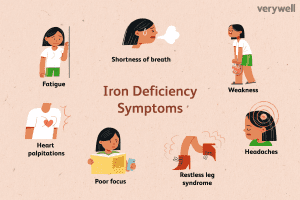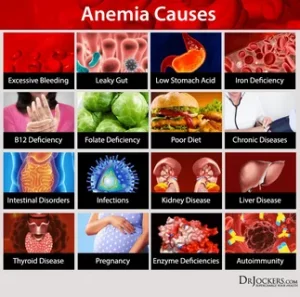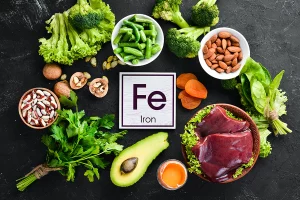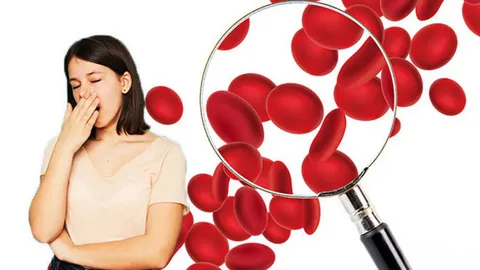Understanding Iron Deficiency Anemia
Iron deficiency anemia is a prevalent condition characterized by insufficient iron levels, leading to a decreased production of red blood cells crucial for oxygen transport. Understanding the multifaceted aspects of this condition is essential for effective management and prevention. Let’s delve into the key components of iron deficiency anemia.
Symptoms of Iron Deficiency Anemia
Iron deficiency anemia often manifests through a range of symptoms, the severity of which depends on the rate at which anemia develops. Common indicators include:
- Tiredness and Lack of Energy (Lethargy): A pervasive feeling of fatigue.
- Shortness of Breath: Difficulty in breathing, particularly during physical activities.
- Noticeable Heartbeats (Heart Palpitations): An awareness of irregular or heightened heartbeats.
- Pale Complexion: Skin appearing paler than usual.
Less common symptoms encompass:
- Headache: Persistent or recurrent headaches.
- Tinnitus: Hearing sounds from within the body, like ringing in the ears.
- Altered Sense of Taste: Changes in the perception of taste.
- Itchiness: Generalized or localized skin itching.
- Sore or Smooth Tongue: Unusual tongue texture.
- Hair Loss: Experiencing hair thinning or loss.
- Pica: A desire to consume non-food items.
- Dysphagia: Difficulty in swallowing.
- Mouth Ulcers: Painful sores at the corners of the mouth.
- Spoon-shaped Nails: Abnormal nail shape.

Causes of Iron Deficiency Anemia
Iron deficiency can result from various factors, with common causes highlighted:
- Monthly Periods: Women with heavy menstrual bleeding (menorrhagia) are susceptible.
- Pregnancy: Increased iron demand for fetal development.
- Gastrointestinal Blood Loss: Common in men and post-menopausal women, attributed to stomach ulcers, NSAIDs, or gastrointestinal cancer.
- Non-steroidal Anti-inflammatory Drugs (NSAIDs): Medications like ibuprofen and aspirin can cause stomach bleeding.
- Stomach Ulcers: Acid erosion leading to bleeding.
- Gastrointestinal Cancer: Rare but a potential cause of slow or unnoticed bleeding.
- Angiodysplasia: Uncommon, caused by abnormal blood vessels in the gastrointestinal tract.
- Chronic Kidney Disease (CKD): Common in CKD patients, managed with iron supplement injections.
- Malabsorption: Inability to absorb iron from food, associated with conditions like coeliac disease or gastrectomy.
- Lack of Iron in Diet: Rare, except in vegetarians/vegans, increased risk when coupled with other factors.

How Iron Deficiency Anemia is Diagnosed
Prompt diagnosis is crucial for effective management. The diagnostic process involves:
- Blood Test: Analyzing levels of hemoglobin, red blood cells, and ferritin (iron-storing protein).
- Vitamin B12 and Folate Testing: Assessing levels if a deficiency is suspected.
Determining the underlying cause may necessitate:
- Lifestyle and Medical History Questions: Exploring diet, medications, menstrual patterns, and family history.
- Physical Examination: Checking for signs of gastrointestinal bleeding or heart failure.
- Rectal Examination: If rectal bleeding is present.
- Pelvic Examination: For women with heavy periods.
Treating Iron Deficiency Anemia
Effective treatment strategies encompass:
- Iron Supplements: Prescribed to restore depleted iron levels; common supplements include ferrous sulphate or ferrous gluconate.
- Dietary Adjustments: Emphasizing iron-rich foods like dark-green leafy vegetables, fortified cereals, meats, and pulses.
- Addressing Underlying Causes: Treating conditions such as gastrointestinal bleeding, stomach ulcers, or heavy menstrual bleeding.

Monitoring and Continuing Treatment
Regular check-ups are essential:
- Monitoring Progress: Blood tests every two to four weeks initially, then every two to four months.
- Continued Iron Supplements: Usually for three months after normalization of hemoglobin levels.
- Ongoing Dietary Advice: Balancing intake of iron-rich foods and considering vitamin C for enhanced absorption.
Comparative Table: Iron Deficiency Anemia Causes
| Cause | Prevalence | Associated Factors |
|---|---|---|
| Monthly periods | Common | Heavy menstrual bleeding (menorrhagia) |
| Pregnancy | Very common | Increased iron demand for fetal development |
| Gastrointestinal blood loss | Common in men and post-menopausal women | Stomach ulcers, NSAIDs, gastrointestinal cancer |
| Non-steroidal anti-inflammatory drugs | Common | Bleeding in the stomach, may require alternative medications |
| Stomach ulcers | Common | Acid erosion leading to bleeding, potential source of iron loss |
| Gastrointestinal cancer | Rare | Potential cause of slow or unnoticed bleeding, may require specialized examination |
| Angiodysplasia | Uncommon | Abnormal blood vessels causing bleeding in the gastrointestinal tract |
| Chronic kidney disease | Common in CKD | Iron deficiency in CKD often managed with iron supplement injections |
| Malabsorption | Various causes | Inability to absorb iron from food, associated with conditions like coeliac disease or gastrectomy |
| Lack of iron in diet | Rare (except in vegetarians/vegans) | Increased risk if coupled with other contributing factors |
Empower yourself with comprehensive knowledge about iron deficiency anemia to foster proactive health management. Consult a healthcare professional for personalized advice and assessment if symptoms persist.











